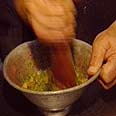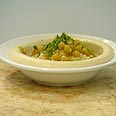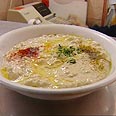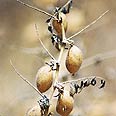



Land of hummus and pita
Ask any Israeli to point out one thing that embodies 'Israeliness'. Chances are nine out 10 will say 'hummus'. What is it about that pale chickpea paste that is eaten everywhere, anytime, that evokes passionate discussions and fan clubs and embodies Israel? Ynet presents the (almost) complete guide to hummus
In any case, chickpeas were prepared and eaten in many different forms thousands of years ago in Asia and the Fertile Crescent region, the Mediterranean and ancient Egypt. The pale spread is only one of the many dishes based on this wonderful legume.
Here is everything you need to know about hummus but were afraid to ask:
A
Abu – The Arabic word for "father of." Although Israelis claim ownership over hummus, no one prepares it better than our Arab neighbors. Any hummus restaurant that respects itself, will be called "Abu-something" (or, rather, "someone")
Arbis – An addictive snack made of cooked, spicy chickpeas traditionally served at celebration dinners following the birth of a son.
B
"Bo Le'nagev?" – Literally: "Come, let's go wipe" (some hummus, that is). The two words that start the ritual of hummus-eating.
Baking Soda – Some will deny it, but there's no better way to soften chickpeas in a reasonable time.
C
Cooking – Two hours. That is more or less the time it will take for the chickpeas to soften enough assuming you soaked them over night with baking soda.
Cumin – A crucial ingredient.
Chips – French fries, the third element of the all-too-popular "hummus-chips-salad" combo.
D
Diet – Forget about it or try eating hummus without the pita.
E
Egg (in Hebrew "beitza") – No one knows how the egg found its way onto the hummus plate, becoming an honorary member in one of the most popular combinations "hummus-ful-beitza"
F
Ful – Cooked broad beans. The competition: In North Africa and particularly in Egypt, ful is much more popular than hummus. Taste is acquired and some Iraqi Jews are very allergic to it.
G
Gas – All-too-common side-effect.
Garlic – one of the basic ingredients.

Hummus-ful
H
Hummus – Oh, well.
I
Ingredients – Everybody agree on the basics - chickpeas, tahini sauce, garlic, baking soda, salt, cumin and lemon – though each self-respecting hummus-maker will swear by their own special secret ingredient.
J
Jaffa – The capital of hummus with restaurants that serve nothing but hummus. Some are open just for a few hours a day, until they run out of the dish.
Jerusalem – Or rather, the Old City, is a another hummus lovers' favorite place.
K
"Komplet" – In Hebrew, "the total package" i.e. hummus-ful-beitza.
L
Lemon – A crucial ingredient in hummus.
M
Messabha – An Arabic word, believed to derive from the word "morning" (subuh in Arabic). A dish that is almost identical to hummus but in different consistency: the chickpeas remain whole and are covered with tahini sauce and olive oil.
N
"N Alav" – Hebrew to express this is the best hummus you've ever had.
O
Onion – Some people say hummus can not be eaten without raw onion. Others swear by olives, hot peppers, tomato or radish. To each his own, though onion is the most popular addition to a plate of hummus. Possibly because it's the cheapest vegetable around. After all, hummus is the poor man's food.
Olive oil – The most expensive ingredient in your hummus. That's the reason in some places, you'll get very little of it or a version that is diluted in water.
P
Pita – Historically the pita is a relative of the pizza. The hollow pita pocket, as we know it, is a
20th-century invention.

A taste of heaven
Q
Quality hummus - At any hummus eatery, the people sitting by the table next to you, are probably arguing about the quality of the hummus. The definition of a good hummus is intangible but is the basis for a very lively conversation.
R
Refill – Some hummus restaurants offer it just in case you're not stuffed.
S
Sumac – Some add sumac to the paste, some sprinkle it on top.
T
Tahini – Sesame-seed paste, the second-most important ingredient of hummus. In Israel most tahini is made in the Arab villages of the Galilee and Nablus.
U
Utensils – See under "wiping."
V
Vegetarian – In recent years, hummus has become popular in trendy vegetarian restaurants abroad due to its nutritional value.
W
Wiping – Unless you don't mind people staring at you and laughing, don't try to eat your hummus with a knife and fork but wipe it off the plate using pieces of pita.

Wiping: It's all in the wrist
X
X-factor – The secret element that makes "your" hummus, the best ever.
Y
"Y, y, y" – The equivalent of saying "the hummus's good, ain't it" with your mouth full.
Z
Z'huq – A very spicy paste made out of coriander, hot peppers, olive oil. Originated in Yemen.
Click here for Shooky Galili's The Hummus Blog















